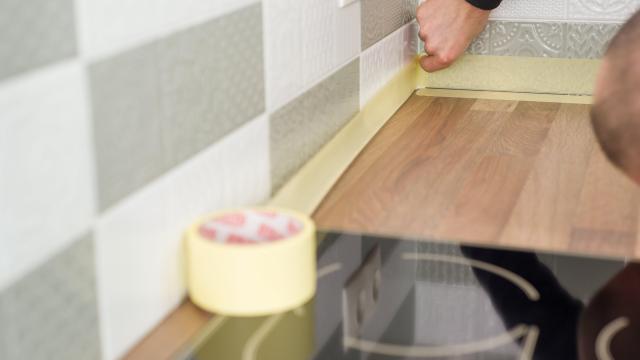When budgeting time and money for your kitchen renovation, set a bit of both aside specifically for your countertops. Counters are notoriously expensive to replace — but they stick out like a sore thumb if outdated and left as-is. If you have out-of-style, scratched, stained, or dull countertops that need a little freshening up (but you don’t want to spring for a full replacement), try painting them.
Tools and materials you’ll need to paint laminate countertops
For this project, you’ll need the following items:
- Sandpaper and a sanding block
- A paint tray and some liners
- Painter’s tape
- Mineral spirits
- A small roller and sleeves
- Latex-based primer
- Paint
- Clear topcoat
- A rag
You can opt to use a powered palm sander, as well, but this project doesn’t require one. Countertop paint kits are available at many hardware stores, too, and they will include the necessary items to refinish your laminate counters. Keep in mind, however, that many of them are one-step or two-step epoxies and will have different directions than the ones below. Follow the instructions that come with your kit for best results.
Prep your countertop surface
To prep the surface, make sure the counters are clean and dry, then sand them with 180- to 220-grit sandpaper. Scoring the surface with the sandpaper will give your finish something to stick to. Use a fine grit, like 250 or above, to sand out any scratches on the surface so your countertop coating will go on smoothly. Finally, use your mineral spirits and rag to clean up the dust from sanding, then allow it to dry.
You’ll also want to tape off areas you don’t want paint. Appliances, fixtures, sinks, and cabinets should all get covered to prevent them from being accidentally painted. It’s also a good idea to put a drop cloth down on the floor. A piece of cardboard or a garbage bag will work in a pinch, too. Make sure to lay your tape smoothly and firmly press the edges down so that paint can’t seep underneath.
Prime, paint, and seal your countertops
Next, you’re going to apply two layers of primer. To avoid streaks and areas that are thicker than others, overlap your strokes with the roller so you’re always painting on a wet edge. Allow your primer to dry between coats — you can use a fan to speed it up. After the second coat, allow your primer to dry for at least an hour before moving on to your paint.
Using a new roller sleeve, apply your paint over top of the primer coats, making sure to overlap your wet edge. Use a paint brush to cut in around corners and on narrow surfaces. To avoid drips, use a roller that is wet, but not dripping paint when it comes out of your paint tray. Once you’ve got one coat down and it’s dry to the touch, you can add a second coat to even out the colour.
The last step is to apply your clear coat and seal in your colour. Using a fresh roller sleeve, apply the clear coat as evenly as possible. Since clear coat can be hard to see, using a light source placed at an angle can be helpful to make sure you don’t miss any spots or drips. Once your clear coat dries, you’re all done.

Leave a Reply
You must be logged in to post a comment.